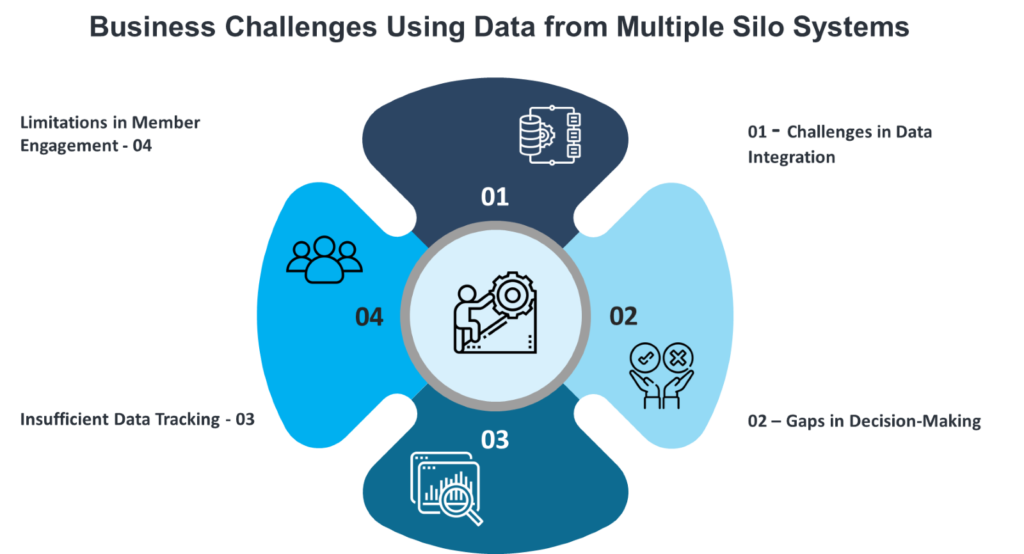Membership associations deal with a large volume of data daily. This data is paramount to the growth, relevance, and effectiveness of these associations. Harnessing this data can present a myriad of benefits and provide a unique opportunity for informed decision-making.
However, multiple technologies and disconnected systems lead to incomplete insights, limiting the associations’ ability to serve their members. In a world where data is a key deciding factor, information silos are a roadblock. They prevent membership associations from generating insightful reports.
In this blog, we will navigate the landscape of silo systems and technologies. We will also discover the game-changing potential of unified data analytics for association empowerment.
Table of Contents
ToggleTop Business Challenges in Generating Reports Using Data from Multiple Silo Systems
Membership associations face challenges in generating specific reports crucial for informed decision-making. This happens because of the presence of silo systems. These silo systems encompass Association Management Systems (AMS), Learning Management Systems (LMS), Events apps, Marketing Automation tools, Accounting Systems and Internal Legacy Systems.
Let us understand these challenges:
1. Challenges in Data Integration
Determining the number of individuals with a specialized certification (e.g., Advanced Professional Credential) across member organizations poses a significant challenge. Data from disparate systems, such as AMS and LMS, often exist in isolation. This reduces the ability to obtain a unified count of the number of Certified individuals.
2. Gaps in Decision-Making
Gaining insights into the attendance of association employees at annual meetings requires collaboration between Events apps and AMS. Siloed data may hinder the creation of a comprehensive report on employee participation in these vital events. This prevents decision making processes and acquiring meaningful insights.
3. Insufficient Data Tracking
The inability to track data from LMS and Events apps may lead to incomplete reporting, hindering training effectiveness assessment. Connecting LMS and AMS for progress monitoring is impeded by data silos, impacting accurate member progress reports and hindering professional development.
4. Limitations in Member Engagement
Determining the typical number of marketing interactions needed for a conversion necessitates combining data from Marketing Automation tools and Customer Relationship Management (CRM) systems. Data silos may hinder the Association’s ability to refine its marketing strategies for optimal member engagement and conversion.

Steps to Address the Challenges for Association Empowerment
Membership groups need a systematic and strategic approach to address data silo challenges and achieve their member engagement goals. A stepwise methodology acts as a guiding framework for ensuring accuracy, managing complexities, and navigating the challenges of unified data management. Let us consider the case of an association UnityConnect Hub, which struggled to optimize its Salesforce platform because of silo systems. These silo systems contained data from LMS, Event Management, Memberships, and Marketing Automation initiatives. UnityConnect Hub was not able to centralize data to generate specific reports. This created a gap in their member engagement objectives. A strategic approach, involving stakeholder sign-off, data identification, technology selection, and unified data collection, successfully addressed their member engagement challenges. Let us look at the step-by-step approach:1. Secure Approval from Stakeholders
Before embarking on a journey to achieve the key objectives, it is necessary to talk to the chief decision-makers. This includes getting their approval and making sure that everyone is on the same page. The steps include:
- Get approval from higher authorities, allocating resources and budget for the project.
- Maintain data governance policies for maintaining data security and creating specific roles and responsibilities.
- Identify all internal and external data sources.
- Create a unified dataset by mapping data from different technologies.
- Select the accurate technology for analyzing data.
2. Find the Data Sources
Associations need to understand the key metrics and identify the data that is scattered across multiple systems. These data sources can be different systems like one for memberships or one for certifications. Data mapping is done to retrieve information for structured decision-making.
3. Choose the Right Technology
To achieve goals, choose technology that turns data into useful insights for association empowerment. Power BI is a useful tool that helps organizations connect data from different systems for better data management.
Benefits of Using Power BI for Data-driven Decision-Making
- Dynamic Visualization– Power BI is an interactive data visualization tool, that enables users gain insights into data collected from various sources. These sources include databases, files, and web services.
- Seamless Data Integration– Power BI connects with other systems to facilitate seamless integration. This empowers membership associations with a unified view of data for comprehensive analysis.
- User-friendly Interface– Power BI’s intuitive interface enables users to reap the benefits of data driven decisions.
- Cost-effective Solution– It is a budget-friendly tool for associations. Power BI offers a range of features without exorbitant licensing fees and has custom pricing options.
- Scaling Without limits– Power BI scales effortlessly with the growing demands of the association. These demands include increasing user needs or growing datasets.
- Interactive Reporting– Power BI enables membership associations to get access to real-time data on any device.
4. Collect and Cleanse Data
The next step for achieving the key metrics is gathering data from different technologies into a centralized data warehouse. This raw data is then cleansed to improve data quality and transformed into the required format. Finally, the data is loaded into Power BI to create custom reports.
The steps are as follows:
- Data Extraction– Collect member data from different technologies like AMS, LMS, Event apps, and Marketing Automation tools. Cleanse the collected data to rectify errors, improve data quality, and remove duplicate data.
- Data Transformation-Transform raw data into a standard format suitable for reporting.
- Data Loading– Load data into Power BI to create custom reports specific to the key metrics. These reports empower membership associations to drive data-driven decision-making.

5. Generate Specific Reports Based on Data
Data loaded in Power BI can generate specific reports that are tailored to the key metrics. Power BI’s intuitive interface creates reports with actionable insights that enable informed decision-making for membership associations. These reports showcase the numbers that address the following metrics:
- Membership organizations and related individuals
- Total number of Certified members
- Members who attended annual events
- Members with recertification
Success for membership associations facing siloed systems hinges on a People, Process, Technology approach. By bringing together the right people, optimizing processes, and utilizing powerful tools like Power BI, associations can steer toward success. This comprehensive strategy fosters growth and positively impacts their member community, with data-driven decisions at the heart of their journey.
Orchestrating Success: The People, Process, Technology Triad for Membership Associations
Associations can achieve their member engagement goals with a people-centric, process-driven, and technology-enhanced approach.
Let us understand the people, process, and technology approach:
People– The people involved in this are the marketing team, event managers, and the learning and development team. The marketing team brings in new members. event managers create memorable events for members. The learning and development team helps members grow and improve their skills.
Process– Data is collected from various technologies and stored in the data warehouse. These technologies include AMS, LMS, Event Apps, Marketing Automation tools, and legacy systems. After data cleansing, this data is loaded in Power BI for insightful reports.
Technology– The technologies used by associations are AMS, LMS, Event apps, accounting systems, Marketing Automation, and Internal Legacy systems. These technologies work in tandem to create a supportive structure for membership associations.
Why Unified Data Opens Doors for Membership Associations?
To succeed in membership associations, connect people, process, and technology through a single database. By seamlessly collecting data from different sources, refining it and choosing the right technology to create reports, associations can empower informed decision-making for success.
Contact Aplusify to boost your membership Association’s success and take it to new heights.









